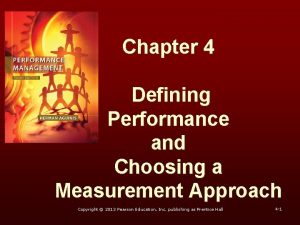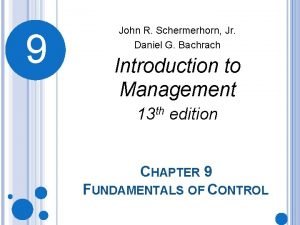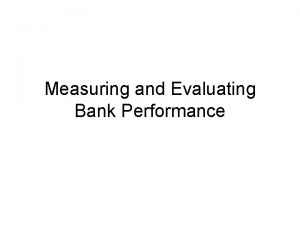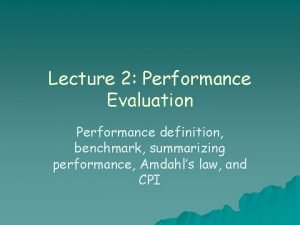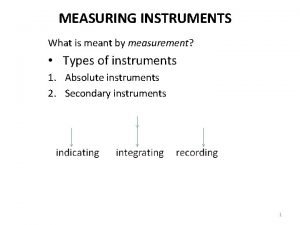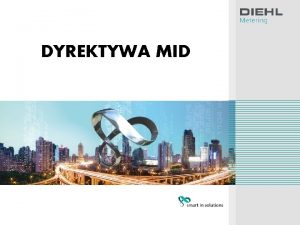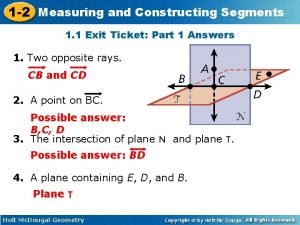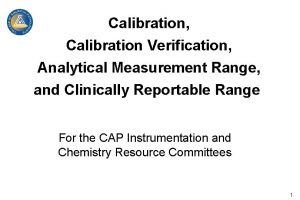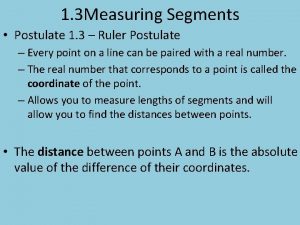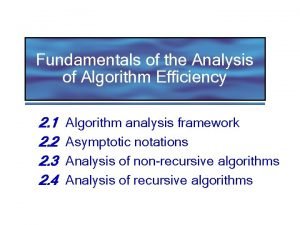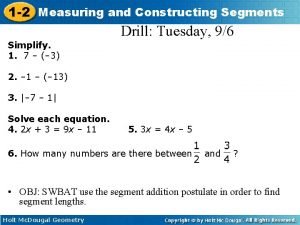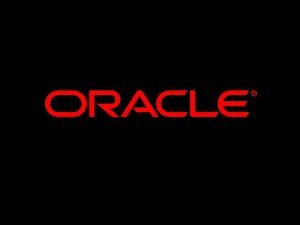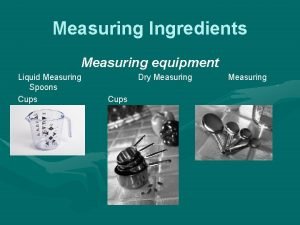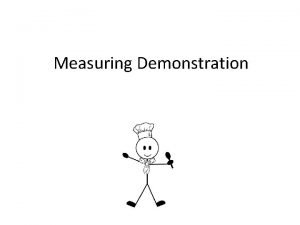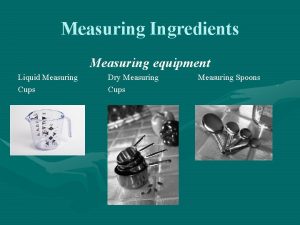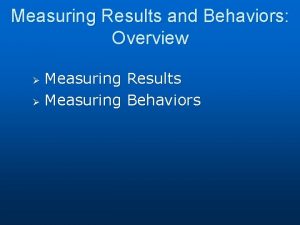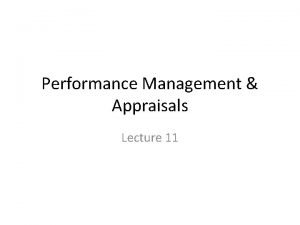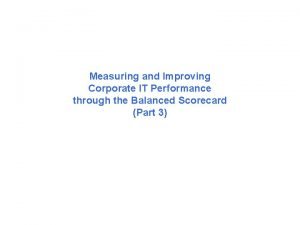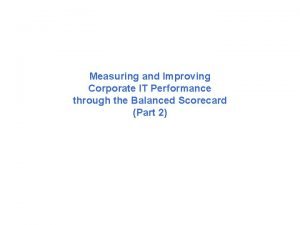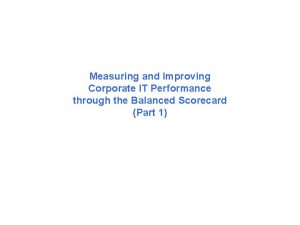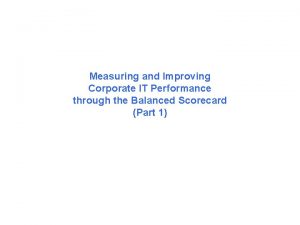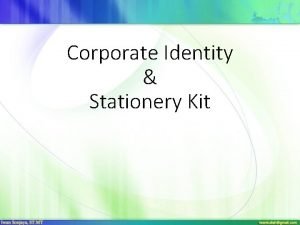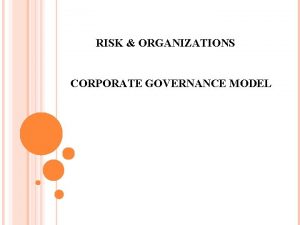Lecture 4 Measuring Corporate Performance 4 1 Corporate
































- Slides: 32

Lecture 4: Measuring Corporate Performance 4 -1

Corporate Performance Calculations: Financial Ratios Underlying Data: Corporate Financials & Market Values 4 -2

Corporate Performance Measured Market Value Add Corporate Performance Economic Value Add • Market Value Add: Market capitalization minus book value of equity. • Economic Value Add: Operating income minus a charge for the cost of capital employed. Also called residual income. • Book Rates of Return: Measure the firm’s profits per dollar of assets. Also known as accounting rates of return because they are based on accounting information (specifically company financials). Three common measures are the return on capital (ROC), the return on equity (ROE), and the return on assets (ROA). Book Rates of Return 4 -3

Market Value Added What is it? Why is it useful? Defined: • Market Capitalization —Total market value of equity, equal to share price times the number of shares outstanding • Market Value Added —Market Capitalization – Book Value of Equity 4 -4

MVA: Discussion TABLE 4. 3 Consider AT&T and Home Depot Similar MVA, Different Market-to-Book Ratio w Limitations of MVA: 1. Market value reflects investors’ expectations about future performance, complete with the imprecisions that come with all forecasting. 2. Market value fluctuates frequently due to reasons outside of the financial managers control. 3. Privately owned corporations do not have a public market value. 4 -5

Economic Value Added = Operating Income minus the product of cost of capital and total capitalization Operating Income = Net Income + After-tax Interest Cost of Capital = The minimum acceptable rate of return on capital investment Total Capitalization = Total Long-term Capital = Equity + Bonds + other Long-term capital [all capital committed by debt and equity investors] Defined: 4 -6

EVA: Discussion TABLE 4. 4 Consider Coca-Cola and Google Similar EVA, Different Return on Capital Why? * Operating Income = Net Income + After-tax Interest; ROC = Return on Capital 4 -7

Book Rates of Return* • Book Rates of Return = Accounting Rates of Return = Measures of the firm’s profits per dollar of assets. • Return on Capital = (after-tax operating income)/(total capitalization) • Return on Assets = (after-tax operating income)/(average total assets) or = (after-tax operating income)/(start of year total assets) • Return on Equity = (net income)/(average equity) or = (net income)/(start of year equity) • Average Assets = (end of period assets + beginning of period assets)/2 • Average Equity = (end of period equity + beginning of period equity)/2 *Book Rates of Return are also referred to as Accounting rates of Return 4 -8

Calculating Return on Capital Lowe’s Balance Sheet (in $m) 4 -9

Calculating Return on Assets Lowe’s Balance Sheet (in $m) 4 -10

Calculating Return on Equity Lowe’s Balance Sheet (in $m) 4 -11

Financial Ratios and Shareholder Value Investment Decisions Efficiency Ratios Profitability Ratios Financing Decisions Leverage Ratios Liquidity Ratios Shareholder value depends on good investment and financing decisions. Financial Ratios help measure the success and soundness of these decisions. 4 -12

Efficiency Ratios • Efficiency Ratios – Ratios which measure how efficiently a firm uses its assets. OR* How does this ratio measure efficiency? * Either equation is a legitimate way to calculate the asset turnover ratio 4 -13

Efficiency Ratios How does this ratio measure efficiency? 4 -14

Calculating an Efficiency Ratio Lowe’s Balance Sheet (in $m) Lowe’s Asset Turnover Ratio 4 -15

Profitability Ratios How does this ratio measure the firm’s profitability? When is this ratio potentially more useful than just profit margin? Note: ROC, ROA, ROE and EVA are also typically considered profitability ratios. 4 -16

Calculating a Profitability Ratio Lowe’s Balance Sheet (in $m) Lowe’s Operating Profit Margin 4 -17

Leverage Ratios How does this ratio measure leverage? 4 -18

Measuring Leverage How does this ratio measure leverage? 4 -19

Calculating a Leverage Ratio Lowe’s Balance Sheet (in $m) Lowe’s Times Interest Earned Ratio COGS stands for Cost of Goods Sold. Expenses include selling, general and administrative costs (and “store operating costs” in this example). 4 -20

Measuring Liquidity How does this ratio measure liquidity? • Liquidity Ratios– Ratios which measure the extent to which the firm has sufficient liquidity in the coming year. • Net Working Capital = Current Assets – Current Liabilities 4 -21

Liquidity Ratios How does this ratio differ form the current ratio? Why might a financial manager prefer it? How does this ratio differ from the current ratio? Why might a financial manager prefer it? 4 -22

Calculating a Liquidity Ratio Lowe’s Balance Sheet (in $m) Lowe’s NWC to Total Assets Ratio 4 -23

The Du. Pont System • Du. Pont System: A breakdown of ROE and ROA into component ratios 4 -24

The Du. Pont System: ROA Asset Turnover Operating Profit Margin 4 -25

ROA Decomposition by Industry 4 -26

The Du. Pont System: ROE Leverage Ratio Asset Turnover Operating Profit Margin Debt Burden The last ratio in the Du. Pont breakdown of ROE is a measure of the firm’s debt burden. The denominator represents free cash flow (Cash available for distribution to investors after the company has paid for any new capital investment or additions to working capital. ). If the ratio is close to zero, the firm has a heavy debt burden —much of its free cash flow goes to interest payments. 4 -27

Sustainable Growth 4 -28

The Role of Financial Ratios Table 4. 8 COMPARABILITY 4 -29

The Role of Financial Ratios TRANSPARENCY 4 -30

Appendix A: Average Ratios, by Industry Table 4. 7 4 -31

Appendix B: Financial Ratios and Default Risk Table 4. 9 4 -32
 01:640:244 lecture notes - lecture 15: plat, idah, farad
01:640:244 lecture notes - lecture 15: plat, idah, farad Corporate governance lecture
Corporate governance lecture Defining performance and choosing a measurement approach
Defining performance and choosing a measurement approach Measuring the actual performance
Measuring the actual performance Occupancy percentage formula
Occupancy percentage formula Measuring the actual performance
Measuring the actual performance Measuring and evaluating bank performance
Measuring and evaluating bank performance Measuring computer performance
Measuring computer performance Measuring the actual performance
Measuring the actual performance Approaches to measuring performance
Approaches to measuring performance Measuring the actual performance
Measuring the actual performance Wbb99
Wbb99 Performance management lecture
Performance management lecture Objectives of corporate finance
Objectives of corporate finance Corporate management performance
Corporate management performance John kotter corporate culture and performance
John kotter corporate culture and performance Disadvantages of bell curve in performance appraisal
Disadvantages of bell curve in performance appraisal Jcids manual 2018
Jcids manual 2018 Behaviorally anchored rating scale
Behaviorally anchored rating scale Measuring tools in automotive
Measuring tools in automotive Capturing customer mindset
Capturing customer mindset Theodolite traversing
Theodolite traversing Types of indicating instruments ppt
Types of indicating instruments ppt Loneliness measurement tool
Loneliness measurement tool Measuring bwc
Measuring bwc Dyrektywa mid
Dyrektywa mid Measuring and constructing segments
Measuring and constructing segments Amr vs linearity
Amr vs linearity Postulate 1-3
Postulate 1-3 Toe load measuring device
Toe load measuring device Element uniqueness problem algorithm analysis
Element uniqueness problem algorithm analysis Measuring and recording apical pulse
Measuring and recording apical pulse 1-2 measuring and constructing segments answer key
1-2 measuring and constructing segments answer key


